Abstract
We have measured the excretion of a major urinary metabolite of thromboxane B2 (TxB2), i.e., 2,3-dinor-TxB2, during the infusion of exogenous TxB2 over a 50-fold dose range to enable estimation of the rate entry of endogenous TxB2 into the bloodstream. Four healthy male volunteers received 6-h i.v. infusions of venhicle alone and TxB2 at 0.1, 1.0, and 5.0 ng/kg X min in random order. They were pretreated with aspirin at a dose of 325 mg/d in order to suppress endogenous TxB2 production. Urinary 2,3-dinor-TxB2 was measured before, during, and up to 24 h after the infusions and in aspirin-free periods, by means of radioimmunoassay. The nature of the extracted immunoreactivity was characterized by thin-layer chromatography and confirmed by negative ion-chemical ionization gas chromatography/mass spectrometry. Aspirin treatment suppressed urinary 2,3-dinor-TxB2 excretion by 80%. The fractional elimination of 2,3-dinor-TxB2 was independent of the rate of TxB2 infusion and averaged 5.3 +/- 0.8%. Interpolation of metabolite values obtained in aspirin-free periods onto the linear relationship between the quantities of infused TxB2 and the amount of metabolite excreted in excess of control values (y = 0.0066x, r = 0.975, P less than 0.001) permitted calculation of the mean rate of entry of endogenous TxB2 into the circulation as 0.11 ng/kg X min. The rate of disappearance of immunoreactive TxB2 from the circulation was monoexponential over the first 10 min with an apparent half-life of 7 min. This corresponded to a maximal estimate of the plasma concentration of endogenous TxB2 of 2.0 pg/ml. These results suggest that ex vivo platelet activation and/or analytical problems confound estimates of endogenous thromboxane release based on plasma TxB2 and provide a rationale for seeking longer-lived enzymatic metabolites of TxB2 in plasma.
Full text
PDF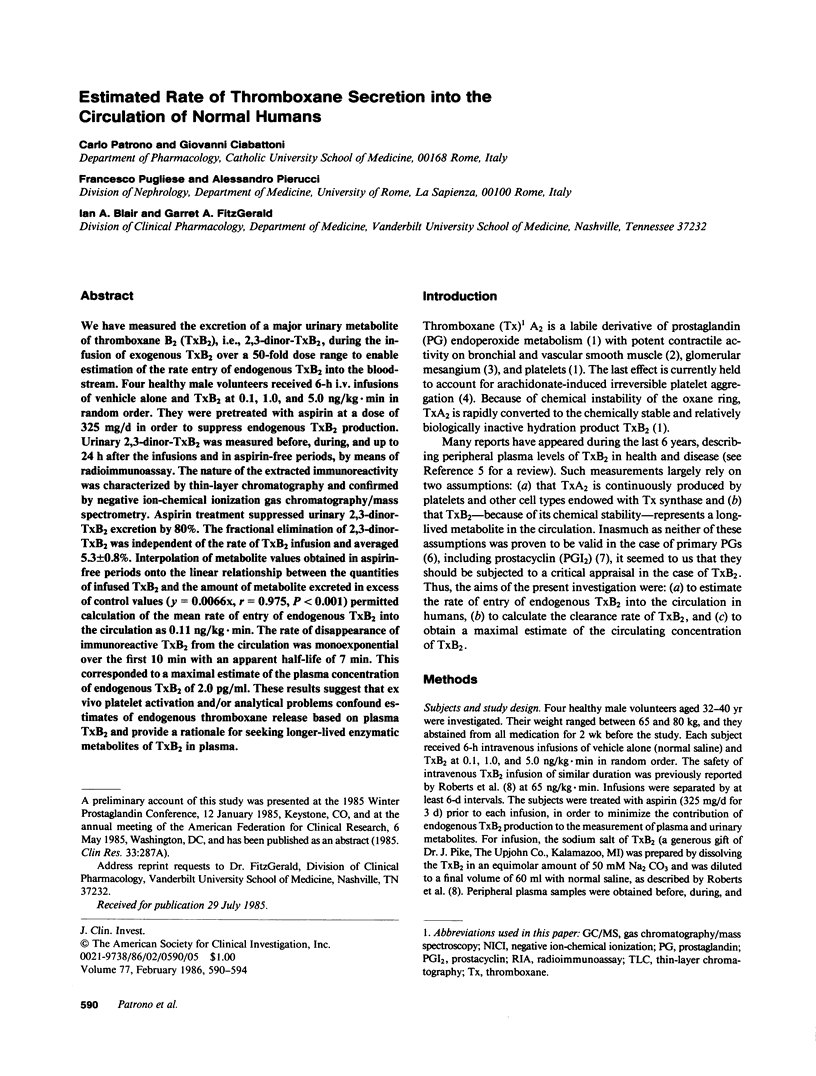
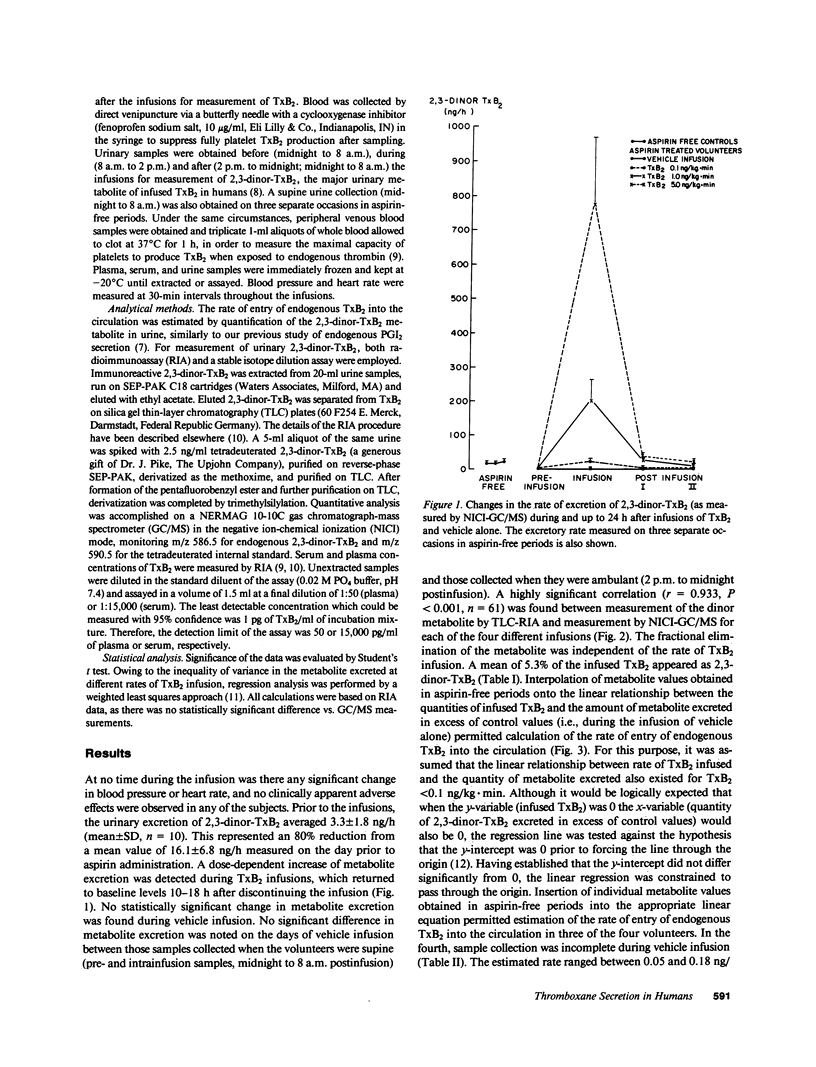
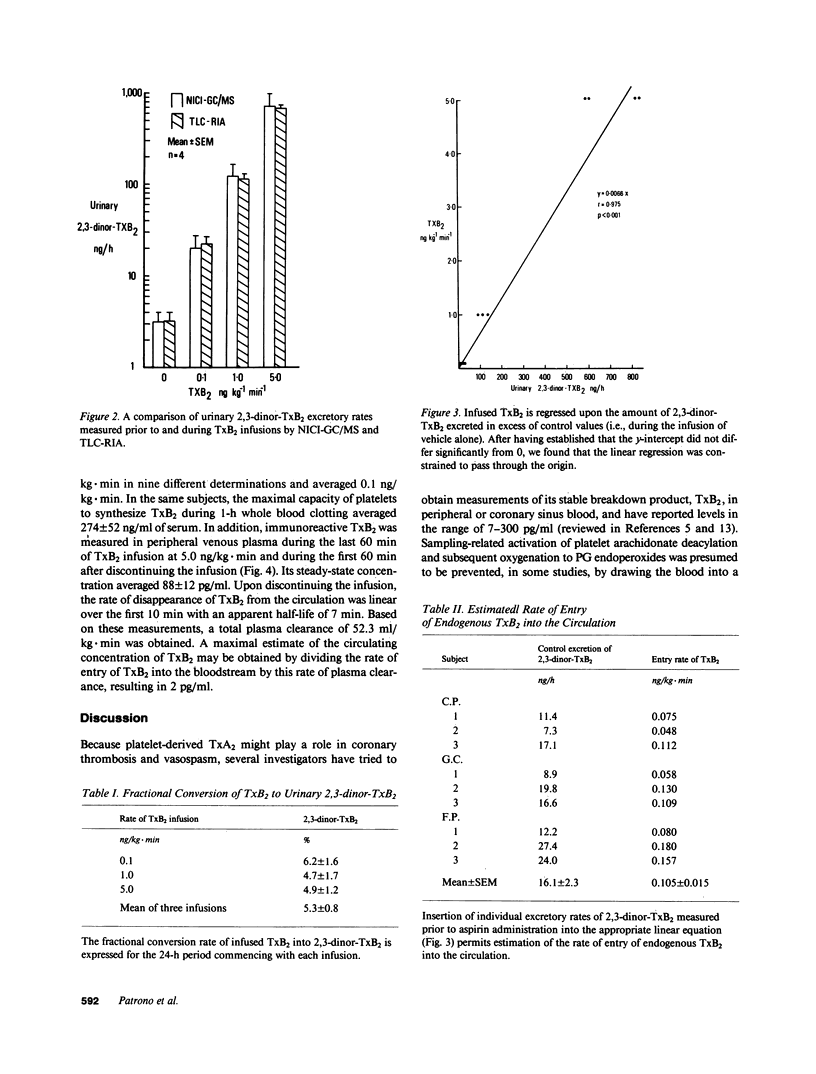
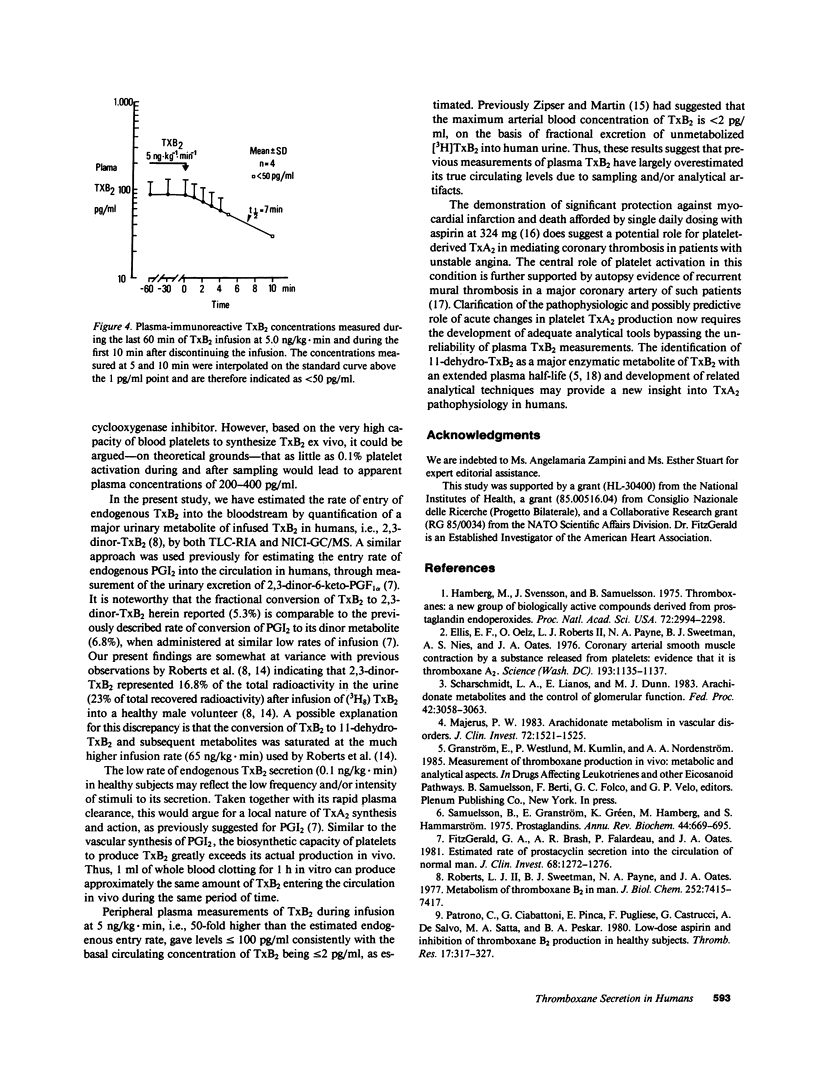
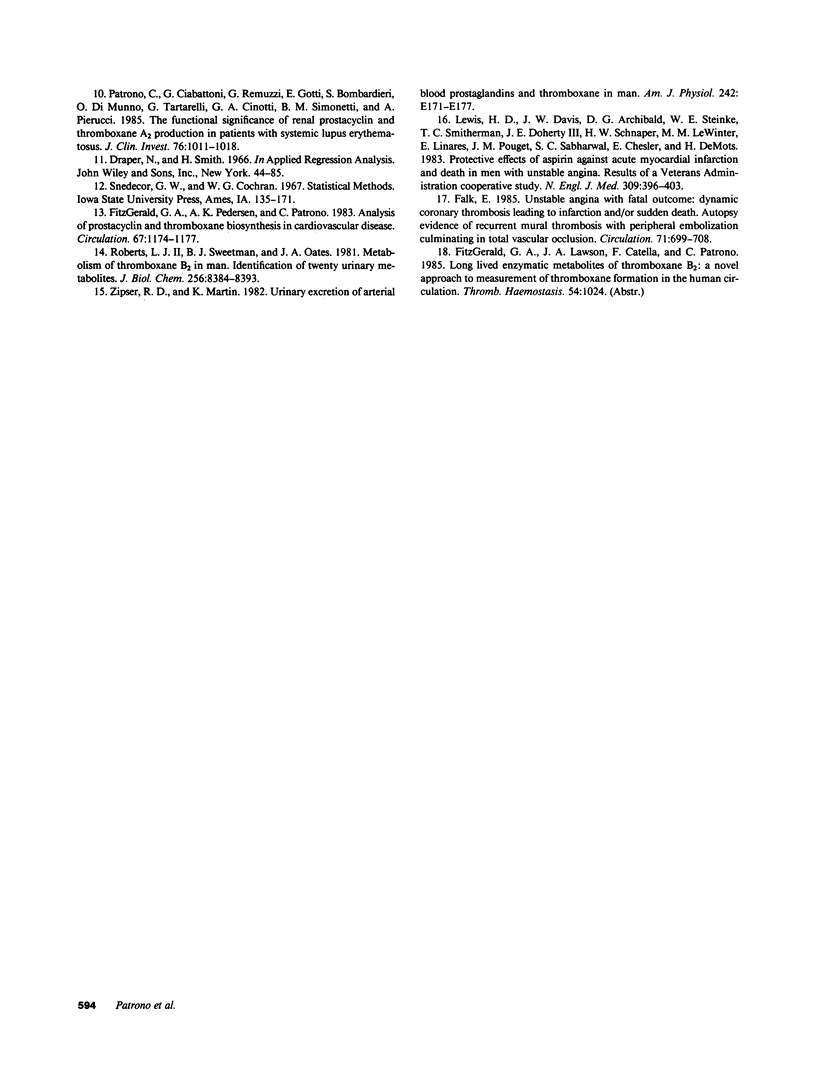
Selected References
These references are in PubMed. This may not be the complete list of references from this article.
- Ellis E. F., Oelz O., Roberts L. J., 2nd, Payne N. A., Sweetman B. J., Nies A. S., Oates J. A. Coronary arterial smooth muscle contraction by a substance released from platelets: evidence that it is thromboxane A2. Science. 1976 Sep 17;193(4258):1135–1137. doi: 10.1126/science.959827. [DOI] [PubMed] [Google Scholar]
- Falk E. Unstable angina with fatal outcome: dynamic coronary thrombosis leading to infarction and/or sudden death. Autopsy evidence of recurrent mural thrombosis with peripheral embolization culminating in total vascular occlusion. Circulation. 1985 Apr;71(4):699–708. doi: 10.1161/01.cir.71.4.699. [DOI] [PubMed] [Google Scholar]
- FitzGerald G. A., Brash A. R., Falardeau P., Oates J. A. Estimated rate of prostacyclin secretion into the circulation of normal man. J Clin Invest. 1981 Nov;68(5):1272–1276. doi: 10.1172/JCI110373. [DOI] [PMC free article] [PubMed] [Google Scholar]
- FitzGerald G. A., Pedersen A. K., Patrono C. Analysis of prostacyclin and thromboxane biosynthesis in cardiovascular disease. Circulation. 1983 Jun;67(6):1174–1177. doi: 10.1161/01.cir.67.6.1174. [DOI] [PubMed] [Google Scholar]
- Hamberg M., Svensson J., Samuelsson B. Thromboxanes: a new group of biologically active compounds derived from prostaglandin endoperoxides. Proc Natl Acad Sci U S A. 1975 Aug;72(8):2994–2998. doi: 10.1073/pnas.72.8.2994. [DOI] [PMC free article] [PubMed] [Google Scholar]
- Lewis H. D., Jr, Davis J. W., Archibald D. G., Steinke W. E., Smitherman T. C., Doherty J. E., 3rd, Schnaper H. W., LeWinter M. M., Linares E., Pouget J. M. Protective effects of aspirin against acute myocardial infarction and death in men with unstable angina. Results of a Veterans Administration Cooperative Study. N Engl J Med. 1983 Aug 18;309(7):396–403. doi: 10.1056/NEJM198308183090703. [DOI] [PubMed] [Google Scholar]
- Majerus P. W. Arachidonate metabolism in vascular disorders. J Clin Invest. 1983 Nov;72(5):1521–1525. doi: 10.1172/JCI111110. [DOI] [PMC free article] [PubMed] [Google Scholar]
- Patrono C., Ciabattoni G., Pinca E., Pugliese F., Castrucci G., De Salvo A., Satta M. A., Peskar B. A. Low dose aspirin and inhibition of thromboxane B2 production in healthy subjects. Thromb Res. 1980 Feb 1;17(3-4):317–327. doi: 10.1016/0049-3848(80)90066-3. [DOI] [PubMed] [Google Scholar]
- Patrono C., Ciabattoni G., Remuzzi G., Gotti E., Bombardieri S., Di Munno O., Tartarelli G., Cinotti G. A., Simonetti B. M., Pierucci A. Functional significance of renal prostacyclin and thromboxane A2 production in patients with systemic lupus erythematosus. J Clin Invest. 1985 Sep;76(3):1011–1018. doi: 10.1172/JCI112053. [DOI] [PMC free article] [PubMed] [Google Scholar]
- Roberts L. J., 2nd, Sweetman B. J., Oates J. A. Metabolism of thromboxane B2 in man. Identification of twenty urinary metabolites. J Biol Chem. 1981 Aug 25;256(16):8384–8393. [PubMed] [Google Scholar]
- Roberts L. J., 2nd, Sweetman B. J., Payne N. A., Oates J. A. Metabolism of thromboxane B2 in man. Identification of the major urinary metabolite. J Biol Chem. 1977 Nov 10;252(21):7415–7417. [PubMed] [Google Scholar]
- Samuelsson B., Granström E., Green K., Hamberg M., Hammarström S. Prostaglandins. Annu Rev Biochem. 1975;44:669–695. doi: 10.1146/annurev.bi.44.070175.003321. [DOI] [PubMed] [Google Scholar]
- Scharschmidt L. A., Lianos E., Dunn M. J. Arachidonate metabolites and the control of glomerular function. Fed Proc. 1983 Nov;42(14):3058–3063. [PubMed] [Google Scholar]
- Zipser R. D., Martin K. Urinary excretion of arterial blood prostaglandins and thromboxanes in man. Am J Physiol. 1982 Mar;242(3):E171–E177. doi: 10.1152/ajpendo.1982.242.3.E171. [DOI] [PubMed] [Google Scholar]


